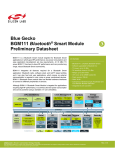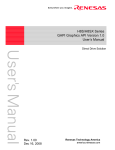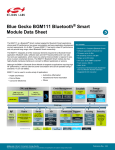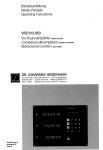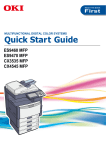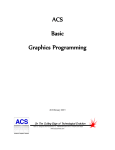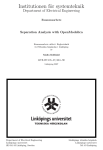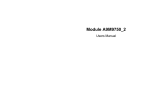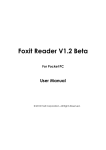Download User Manual for GAPI
Transcript
Renesas GAPI Graphics API
Revision 2.01
User's Manual
All information contained in these materials, including products and product specifications,
represents information on the product at the time of publication and is subject to change by
Renesas Electronics Corp. without notice. Please review the latest information published by
Renesas Electronics Corp. through various means, including the Renesas Electronics Corp.
website (http://www.renesas.com).
Revision 2.01 July 18, 2012
General Precautions in the Handling of MPU/MCU Products
The following usage notes are applicable to all MPU/MCU products from Renesas. For detailed usage notes on the
products covered by this manual, refer to the relevant sections of the manual. If the descriptions under General
Precautions in the Handling of MPU/MCU Products and in the body of the manual differ from each other, the description
in the body of the manual takes precedence.
1. Handling of Unused Pins
Handle unused pins in accord with the directions given under Handling of Unused Pins in the manual.
The input pins of CMOS products are generally in the high-impedance state. In operation with
unused pin in the open-circuit state, extra electromagnetic noise is induced in the vicinity of LSI, an
associated shoot-through current flows internally, and malfunctions occur due to the false
recognition of the pin state as an input signal become possible. Unused pins should be handled as
described under Handling of Unused Pins in the manual.
2. Processing at Power-on
The state of the product is undefined at the moment when power is supplied.
The states of internal circuits in the LSI are indeterminate and the states of register settings and
pins are undefined at the moment when power is supplied.
In a finished product where the reset signal is applied to the external reset pin, the states of pins
are not guaranteed from the moment when power is supplied until the reset process is completed.
In a similar way, the states of pins in a product that is reset by an on-chip power-on reset function
are not guaranteed from the moment when power is supplied until the power reaches the level at
which resetting has been specified.
3. Prohibition of Access to Reserved Addresses
Access to reserved addresses is prohibited.
The reserved addresses are provided for the possible future expansion of functions. Do not access
these addresses; the correct operation of LSI is not guaranteed if they are accessed.
4. Clock Signals
After applying a reset, only release the reset line after the operating clock signal has become stable.
When switching the clock signal during program execution, wait until the target clock signal has
stabilized.
When the clock signal is generated with an external resonator (or from an external oscillator)
during a reset, ensure that the reset line is only released after full stabilization of the clock signal.
Moreover, when switching to a clock signal produced with an external resonator (or by an external
oscillator) while program execution is in progress, wait until the target clock signal is stable.
5. Differences between Products
Before changing from one product to another, i.e. to one with a different part number, confirm that the
change will not lead to problems.
The characteristics of MPU/MCU in the same group but having different part numbers may differ
because of the differences in internal memory capacity and layout pattern. When changing to
products of different part numbers, implement a system-evaluation test for each of the products.
All trademarks and registered trademarks are the property of their respective owners.
Table of Contents
1. Introduction ........................................................................................................................................ 5
1.1
1.2
1.3
1.4
1.5
1.6
1.7
1.8
GAPI Overview ........................................................................................................................................................ 5
Philosophy ...................................................................................................................................................... 5
Capabilities ..................................................................................................................................................... 5
BMP Creation ........................................................................................................................................................... 6
BMP Format ................................................................................................................................................... 6
Color Information ........................................................................................................................................... 6
RLE (Run Length Encoding) Compression.................................................................................................... 7
BMP Transparency ......................................................................................................................................... 7
2. API Information ............................................................................................................................... 10
2.1.1
2.1.2
2.1.3
2.1.4
2.1.5
2.1.6
2.1.7
Header Files.................................................................................................................................................. 10
Configuration ............................................................................................................................................... 10
Integer Types ................................................................................................................................................ 10
GAPI Data Types ......................................................................................................................................... 10
Macro Definitions ........................................................................................................................................ 10
Dependencies ............................................................................................................................................... 11
Data Sections ................................................................................................................................................ 11
3. GAPI Definition ............................................................................................................................... 12
3.1
BMP Access and Creation ...................................................................................................................................... 12
3.1.1
R_BMP_Init ................................................................................................................................................. 12
3.1.2
R_GAPI_24_Disp ........................................................................................................................................ 13
3.1.3
R_BMP_Height ............................................................................................................................................ 14
3.1.4
R_BMP_Width ............................................................................................................................................. 15
3.1.5
R_BMP_Offset ............................................................................................................................................. 16
3.1.6
R_BMP_FileSize .......................................................................................................................................... 17
3.1.7
R_BMP_IndexColors ................................................................................................................................... 18
3.2
BMP Copy Routines ............................................................................................................................................... 19
3.2.1
R_GAPI_CopySub ....................................................................................................................................... 20
3.2.2
R_GAPI_Copy ............................................................................................................................................. 23
3.2.3
R_GAPI_CopyTransparent .......................................................................................................................... 24
3.2.4
R_GAPI_CopyMulK .................................................................................................................................... 25
3.2.5
R_GAPI_CopyMulC .................................................................................................................................... 26
3.2.6
R_GAPI_CopyMulT .................................................................................................................................... 27
3.3
Font Draw Routines ................................................................................................................................................ 28
3.3.1
R_GAPI_PutS .............................................................................................................................................. 28
3.3.2
Font Generation Utilities .............................................................................................................................. 31
3.3.3
R_GAPI_FontWidthString ........................................................................................................................... 32
3.3.4
LCDBMP_FontHeight ................................................................................................................................. 33
3.4
Fill and Translate Routines ..................................................................................................................................... 34
3.4.1
R_GAPI_Fill ................................................................................................................................................ 34
3.4.2
R_GAPI_FillMulK ....................................................................................................................................... 35
3.4.3
R_GAPI_FillGradient .................................................................................................................................. 36
3.4.4
R_GAPI_CopyXlate ..................................................................................................................................... 37
3.5
Other Routines ........................................................................................................................................................ 39
3.5.1
R_GAPI_Index ............................................................................................................................................. 39
3.5.2
R_GAPI_ColorCopy .................................................................................................................................... 40
3.5.3
R_GAPI_Scroll ............................................................................................................................................ 41
3.5.4
R_GAPI_CalcGradientCTN ......................................................................................................................... 42
3.5.5
R_GAPI_CalcShadeCT ................................................................................................................................ 43
3.5.6
3.5.7
3.5.8
3.5.9
R_GAPI_Label ............................................................................................................................................. 44
R_GAPI_Button ........................................................................................................................................... 45
R_GAPI_PoolMemoryGet ........................................................................................................................... 46
R_GAPI_PoolMemoryFree .......................................................................................................................... 47
Renesas GAPI Graphics API
Renesas MCU
GAPI Graphics API Revision 2.01
Revision 2.01
July 18, 2012
1. Introduction
1.1
GAPI Overview
The GAPI Graphics API is a set of routines to allow for the simple creation and manipulation of raster based
images in RAM memory frames. In turn, these memory frames can be treated as input into the GAPI routines
(allowing for the creation of complex composite images). Once the desired image has been created, the frame
can be used as the display buffer for an LCD panel.
1.2
Philosophy
GAPI was developed to provide a set of tools that could be used to illustrate the use of the Renesas LCD
graphic solution capabilities. GAPI is freely available to users as part of the Renesas LCD graphic solutions,
and includes access to the source code for use on Renesas MCUs. While the solution is not as powerful as
rd
some of our 3 party partners, it is usable for many types of user interfaces and as an evaluation platform
during the MCU decision making process. Through re-use of source images and building of composite images
at run-time, the GAPI is a very efficient tool for creating solutions that fit completely within the on chip flash
memory resources of the MCU.
1.3
Capabilities
The current capabilities of the GAPI include:
Ability to use most standard BMP formats as input.
Ability to create and place anti-aliased text strings arbitrarily into a frame.
Ability to fill regions of a frame with solid or gradient colors.
Ability to transform colors and blend BMP inputs to suit application needs at runtime.
Create 16bpp output frame for LCD raster display use.
Utilizing these relatively few functions allows for the creation of efficient, attractive user interfaces with
relatively little coding overhead.
Revision 2.01
July 18, 2012
Page 5 of 53
Renesas GAPI Graphics API
1.4
BMP Creation
Because the GAPI accepts most standard BMP formats, the creation of graphic content is a simple matter
using widely available tools such as MS Paint, GIMP and PhotoShop. This section covers a few key points
about BMP formats that allow for their optimal use with GAPI.
1.5
BMP Format
The file format of BMP files consists of two pieces; a header describing the image, and a raster containing the
image. The header contains information on the height, width, color format of the raster, and optionally an
index table to decode the raster color data.
1.6
Color Information
The BMP format allows for tradeoffs in raster size .vs color depth. The raster can be stored as 1, 4, 8, 16, 24
or 32 BPP (bits per pixel). Depending on the software tool, there are different methods to generate the
various BMP formats, but often it will be found under a “save as” menu.
BPP
Number of Colors
Pixel Format
Size of 320x240 Image
1 bpp
2 (indexed)
8:8:8
9.6 Kbytes
4 bpp
16 (indexed)
8:8:8
38.4 Kbytes
4 bpp RLE
16 (indexed)
8:8:8
varies
8 bpp
256 (indexed)
8:8:8
76.8 Kbytes
8 bpp RLE
256 (indexed)
8:8:8
varies
16 bpp
64K
5:6:5
153.6 Kbytes
24 bpp
24M
8:8:8
230.4 Kbytes
32 bpp
24M with
transparency
8:8:8 + 8 alpha
307.2 Kbytes
A few points from this data.
The indexed formats do not contain the color data within the raster, they contain an index into a color
lookup table (contained in the BMP header). So while these formats have a limited number of colors
available, those colors can be any color within a 24-bit 8:8:8 (red:green:blue) color space. For
example in 1 BPP BMP, the two color choices could be:
(173:44:201) and
(36:132:206).
All output data is converted to 16bpp for display. When using 8:8:8 color formats, there is associated
size and conversion overhead that may not justify their use. The additional color data in 24bpp and
32bpp BMP formats are just discarded, so there is no reason to use this formats with GAPI (unless
the transparency information is used).
There is overhead in the lookup process for indexed formats, however this process is optimized and
often this overhead is justified for the size savings. Additionally, because the index tables can be
manipulated at runtime, it makes the changing of the coloring of images in this format at runtime
practical.
Small images that are not going to have their colors changed are most efficiently saved in 16bpp
formats. This avoids the size overhead of the index table, as well as the table lookup execution
overhead.
In general, most images do not need to be saved at 16bpp and indexed forms yield accurate coloring.
When creating large background images, it is advised to create content that looks “good” in one of the
indexed formats to conserve space. Alternatively, using solid or gradient backgrounds can consume
no space as they are generated at runtime by the GAPI.
Revision 2.01
July 18, 2012
Page 6 of 53
Renesas GAPI Graphics API
The following illustrates the differences in some of the different formats. Often where you will see issues is in
subtle transitions in shading. In non-photo images, often there is little to no appreciable loss of quality.
Figure 1 24-bpp original
Figure 2 16-bpp
Figure 3 8-bpp
Figure 4 4-bpp
1.7
RLE (Run Length Encoding) Compression
GAPI supports RLE compression on 4Bpp and 8bpp index BMPs. RLE is a simple compression mechanism
that depends on having “strings” of pixels with the same value. Because of this, the amount of compression is
highly dependent on the source content. Because of this ensure that amount of compression justifies the
overhead of decoding the RLE. For images where there is only a 10% space savings (as in Figure 6), you
may incur a 50% increase in the time to render the image compared to non-RLE; however where the image
has high compression (as in Figure 5), the amount if time to render the image can actually be the same or
less as non-RLE (as the longer strings of pixels are efficiently rendered).
Figure 5 320x240 12.3Kb
Figure 6 320x240 67.9Kb
1.8
BMP Transparency
Most BMP formats do not inherently support transparency, but with proper file construction, the GAPI tool can
(optionally) interpret a “magic color” value as being “transparent”. There are two ways to accomplish this.
With 16bpp source images, when calling the “copy” API routines, you can specify a designated 16bpp
pixel value to be treated as transparent “magic color”. During the copy process, this “transparent”
color is not copied to the destination raster. On the source BMP fill any “transparent” areas with this
color you are designating. It is often easiest to always use the same color and keep it in tool palette.
Here the green color is used to specify the transparent color and the value is passed as the
transparent argument to the copy routines.
With indexed BMP formats and using some tools (notably Photoshop). You can save transparent
areas of the source image into the BMP by designating a “magic color” index as part of the index table
Revision 2.01
July 18, 2012
Page 7 of 53
Renesas GAPI Graphics API
(this “magic color” is the last used index in the table). When transparency is specified during the
creation of the index table, this index value is automatically used for any transparent areas. When
calling the BMP copy routines, specifying the last index value of the table as transparent will prevent
those pixels from being copied to the destination BMP.
Original Photoshop Document.
Convert to indexed mode.
Resultant color table with transparency. Save this file as an 8Bpp BMP format. Note that when
opened with other programs or even Photoshop after the save, the “transparency” color will be
represented as white. But the “transparent” area will still correspond to this index value.
This “magic color” technique can yield effective results with small easy to construct BMPs. However,
because the a pixel is either “copied” or “not copied” (transparent), the image edges can appear
jagged and there is no capability to “blend” an edge pixel into the background pixels.
These issues can be avoided by use of BMPs that contain an “alpha” (transparency) channel. When
rendering images with the alpha channel, the image is seamlessly “blended” into the background.
can be blended into a frame to produce
Also, grayscale images such as this 8bpp RLE
Revision 2.01
July 18, 2012
.
can be used as an “alpha mask” and
Page 8 of 53
Renesas GAPI Graphics API
transparently rendered onto frame to produce
. Note that the “solid” white color in
the source image can be changed at runtime to any color, any pixel that is not “solid” white has the
coloring applied and is blended into the destination image on a pixel by pixel basis.
The detailed API calls in this manual will provide examples of how this is achieved.
Revision 2.01
July 18, 2012
Page 9 of 53
Renesas GAPI Graphics API
2. API Information
The GAPI API follows the Renesas API naming standards.
Additionally, it follows the Renesas Integrated Firmware Development conventions.
2.1.1
Header Files
All API calls are accessed by including a single file “r_GAPI.h” located in the common r_Packages include
directory. This header file in turn references several header files buried in the GAPI package. These “subheader” files are all named “r_GAPI_xxx.h” where “xxx” denotes a class of functions. These files can be
located within the HEW “dependencies” tree.
2.1.2
Configuration
The GAPI package configuration is located in “config_r_GAPI.h”. After any configuration changes, the
package will need to be rebuilt.
Attribute
Purpose
Raster_t
The Raster_t typdef specifies the data type of the raster memory. Typically this
will be set to “uint16_t”.
GAPI_MEMORY_POOLS
This determines the number of 256 and 1024 byte memory pools that are
allocated by GAPI for use by the r_GAPI_PoolMemory routines. This value must
be at least 2 when using these routines with GAPI (assumes no application usage
and a single thread using the GAPI).
Setting this value to 0 will build the package without integrated pool support. The
user code is then responsible for supplying the R_GAPI_PoolMemory routines.
2.1.3
Integer Types
The GAPI uses ANSI C 99 “Exact width integer types” in order to make the code clearer and more portable.
These types are defined in “stdint.h”.
2.1.4
GAPI Data Types
These data types are used within the API to support graphics data structures.
/* Data structure of BMP color table entry */
typedef struct BMP_ColorTable_t;
/* BMP header structure */
typedef struct BMP_t;
/* Data type of the output raster (user configuration) */
typedef uint32_t Raster_t;
/* structure definition for font information */
typedef struct GAPI_PUT_t;
/* structure definition for higher level color/font schemes */
typedef struct GAPI_Scheme_t;
2.1.5
Macro Definitions
These macros are defined as a convenience to the user in specifying common colors.
#define
#define
#define
#define
#define
#define
#define
#define
#define
#define
#define
Revision 2.01
July 18, 2012
CT_WHITE
CT_BLACK
CT_RED
CT_GREEN
CT_BLUE
CT_CYAN
CT_MAGENTA
CT_YELLOW
CT_GRAY_25
CT_GRAY_50
CT_GRAY_75
{0xFF,
{0x00,
{0x00,
{0x00,
{0xFF,
{0xFF,
{0xFF,
{0x00,
{0x40,
{0x80,
{0xC0,
0xFF,
0x00,
0x00,
0xFF,
0x00,
0xFF,
0x00,
0xFF,
0x40,
0x80,
0xC0,
0xFF,
0x00,
0xFF,
0x00,
0x00,
0x00,
0xFF,
0xFF,
0x40,
0x80,
0xC0,
0x00}
0x00}
0x00}
0x00}
0x00}
0x00}
0x00}
0x00}
0x00}
0x00}
0x00}
Page 10 of 53
Renesas GAPI Graphics API
2.1.6
Dependencies
The Graphics API requires the FreeRTOS package if GAPI_MEMORY_POOLS is not zero.
2.1.7
Data Sections
In addition to the standard compiler sections, the Graphics API uses the BGAPI_POOL* sections to provide
temporary pool memory if GAPI_MEMORY_POOLS is not zero. The user project linker options must properly
map this section to the appropriate memory location (internal RAM).
Revision 2.01
July 18, 2012
Page 11 of 53
Renesas GAPI Graphics API
3. GAPI Definition
3.1
BMP Access and Creation
Internally, the GAPI wraps all raster images with a BMP header to maintain information about the content of
the raster data. This wrapper is in the form of an industry standard BMP format. The following functions return
information about a given BMP or provide for initialization of an internally allocated BMP wrapper for a raster.
All BMP coordinate information follows the Window’s standard (0,0 is in the lower left corner)
3.1.1
R_BMP_Init
Initialize an allocated BMP_t structure.
Format
GAPI_Resp_t R_BMP_Init
(BMP_t *const d, uint32_t r, const uint8_t bpp,
const int16_t Width, const int16_t Height);
Parameters
d
Pointer to the user allocated structure to be initialized.
r
Pointer to the user allocated raster that this BMP will be using (as 32bit value…not pointer).
bpp
Bits per pixel of raster, the following are acceptable values:
24, 16, 8, 4, 1: The BMP_t structure will be initialized appropriately.
BMP_DISP_BPP: This is a special value that should be used for creating display frames.
Width
Width of the frame associated with this raster.
Height
Height of the frame associated with this raster.
Return Values
0 if successful, non-zero if failure.
Properties
Prototyped in file ”r_GAPI.h”
Description
This function is called to initialize a user allocated BMP structure for a given raster to allow its use by other
GAPI functions.
Example
BMP_t wrapper;
Raster_t raster[160L*120L]
{
R_BMP_Init (&wrapper, (uint32_t)raster, BMP_DISP_BPP, 160, 120);
}
Revision 2.01
July 18, 2012
Page 12 of 53
Renesas GAPI Graphics API
3.1.2
R_GAPI_24_Disp
Conversion routine from an 8:8:8 pixel data to a display pixel data.
Format
uint16_t R_GAPI_24_Disp (BMP_ColorTable_t const *const p24 );
Parameters
p24
Pointer to the 8:8:8 pixel data.
Return Values
5:6:5 pixel data.
Properties
Prototyped in file ”r_GAPI.h”
Description
Converts 24bpp RGB data to 16bpp 5:6:5 RGB data.
Note that HW_BYTE_SWAPPED_BUS can be defined to configure the code to compensate for the
connection of the MCU to the LCD panel. In the case of the big endian H8S family connected R5:G6:B5 to
D15:D0 do not define HW_BYTE_SWAPPED_BUS, in the case of connection as G3:B5:R5:G3 to D15:D0 do
define HW_BYTE_SWAPPED_BUS.
Example
BMP_ColorTable_t CT;
{
uint16_t pixel= LCDBMP24_16( &CT );
}
Revision 2.01
July 18, 2012
Page 13 of 53
Renesas GAPI Graphics API
3.1.3
R_BMP_Height
Extract height information from BMP_t structure.
Format
int16_t R_BMP_Height(BMP_t const *const pBmp);
Parameters
pBmp
Pointer to the BMP structure.
Return Values
Height of the raster as defined in the BMP structure.
Properties
Prototyped in file ”r_GAPI.h”
Description
Request the height field of the BMP structure. While the BMP format allocates 4 bytes to this field, this API
uses at most a 16 bit size.
Example
BMP_t wrapper;
{
int16_t height= R_BMP_Height(&wrapper);
}
Revision 2.01
July 18, 2012
Page 14 of 53
Renesas GAPI Graphics API
3.1.4
R_BMP_Width
Extract width information from BMP_t structure.
Format
int16_t R_BMP_Width(BMP_t const *const pBmp);
Parameters
pBmp
Pointer to the BMP structure.
Return Values
Width of the raster as defined in the BMP structure.
Properties
Prototyped in file ”r_GAPI.h”
Description
Request the width field of the BMP structure. While the BMP format allocates 4 bytes to this field, this API
uses at most a 16 bit size.
Example
BMP_t wrapper;
{
int16_t width= R_BMP_Width(&wrapper);
}
Revision 2.01
July 18, 2012
Page 15 of 53
Renesas GAPI Graphics API
3.1.5
R_BMP_Offset
Extract offset to raster information from BMP_t structure.
Format
int32_t R_BMP_Offset(BMP_t const *const pBmp);
Parameters
pBmp
Pointer to the BMP structure.
Return Values
Offset of the raster as defined in the BMP structure.
Properties
Prototyped in file ”r_GAPI.h”
Description
Request the offset to raster field of the BMP structure. Normally the raster immediately follows the variable
length BMP wrapper information. This offset is the distance (in bytes) to the raster from the start of the BMP
structure
Example
BMP_t wrapper;
{
Raster_t *pRaster = (pRaster *)((uint8_t *)&wrapper + R_BMP_Offset (&wrapper));
}
Revision 2.01
July 18, 2012
Page 16 of 53
Renesas GAPI Graphics API
3.1.6
R_BMP_FileSize
Extract size of BMP file (wrapper + raster) information from BMP_t structure.
Format
uint32_t R_BMP_FileSize(BMP_t const *const pBmp);
Parameters
pBmp
Pointer to the BMP structure.
Return Values
File size of BMP.
Properties
Prototyped in file ”r_GAPI.h”
Description
Returns total size of the BMP file (wrapper + raster)
Example
extern BMP_t *picture;
{
uint32_t size = R_BMP_FileSize(picture);
}
Revision 2.01
July 18, 2012
Page 17 of 53
Renesas GAPI Graphics API
3.1.7
R_BMP_IndexColors
Determine number of significant colors in the BMP color table.
Format
uint32_t R_BMP_IndexColors(BMP_t const *const pBmp);
Parameters
pBmp
Pointer to the BMP structure.
Return Values
Number of significant colors in the index table, 0 if not an indexed format.
Properties
Prototyped in file ”r_GAPI.h”
Description
BMP index tables can have a variable amount of defined colors (up to 256). This function returns that number
active in this BMP.
Example
extern BMP_t *picture;
{
uint32_t colors = R_BMP_IndexColors(picture);
}
Revision 2.01
July 18, 2012
Page 18 of 53
Renesas GAPI Graphics API
3.2
BMP Copy Routines
Several routines are provided to manipulate and copy rasters as defined in this section. Unless noted
otherwise, these routines are capable accepting the following raster formats. The output (destination format)
for all of these routines is Raster_t in 5:6:5 format.
Raster Type
(bits per pixel)
Max Index
Table
Entries
Pixel
Format
1 bpp
2
8:8:8
4 bpp
16
8:8:8
4 bpp RLE
8 bpp
8 bpp RLE
16
8:8:8
256
8:8:8
256
8:8:8
16 bpp
0
5:6:5
24 bpp
0
8:8:8
32 bpp
0
8:8:8:8
Revision 2.01
July 18, 2012
Notes
Run Length Encoded.
Files with only one index color may not be able to be
processed when RLE compressed, if this is the case,
nd
please force 2 colors and use 2 color for fill.
Run Length Encoded.
Files with only one index color may not be able to be
processed when RLE compressed, if this is the case,
nd
please force 2 colors and use 2 color for fill.
Alpha channel processed as transparency value.
Page 19 of 53
Renesas GAPI Graphics API
3.2.1
R_GAPI_CopySub
Copies source BMP to destination BMP. This is the underlying function used by the following wrapper BMP
copy functions and offers much control over the copy.
Generally, the simplified wrapper copy routines will yield more readable code and should be used unless they
don’t meet the application need.
Format
GAPI_Resp_t R_GAPI_CopySub( BMP_t const *const s, BMP_t *const d,
int16_t dPosX, int16_t dPosY, int16_t sPosX, int16_t sPosY,
int16_t Width, int16_t Height, BMP_ColorTable_t const *const ct,
uint32_t tr );
Parameters
s
Pointer to the source BMP structure.
d
Pointer to the destination BMP structure.
dPosX
X axis offset within destination raster to place source.
dPosY
Y axis offset within destination raster to place source.
sPosX
X axis offset within source raster to copy from.
sPosY
Y axis offset within source raster to copy from.
Width
Width of source raster area to copy.
Height
Height of source raster area to copy.
ct
Pointer to color table to use for pixel conversion/copy.
tr
Utilize the TRANSPARENCY(mode,value) macro to generate an appropriate value.
Return Values
0 if successful, non-zero if failure.
Properties
Prototyped in file ”r_GAPI.h” (details in r_gapic_core.h).
Description
This routine will copy/merge the raster data of a source BMP to the raster data of a destination BMP.
Translation of the source pixel Bpp type will automatically be performed to the type specified in the destination
BMP Bpp type (currently destination must be the display raster type).
Clipping will be performed based on the supplied Width/Height parameters. No data will be copied from
outside the boundaries of source raster nor will any data be written outside the boundaries of the destination
raster.
The ability to specify a color table allows runtime recoloring of images. A runtime color table can be generated
using GAPI calls such as R_GAPI_CalcGradientCTN and R_GAPI_CalcShadeCT.
Revision 2.01
July 18, 2012
Page 20 of 53
Renesas GAPI Graphics API
A key feature of this function is the ability to specify transparency transformation. The value to pass for the tr
argument is generated by the TRANSPARENCY(mode, value) macro as follows:
mode
GAPI_T_NONE
GAPI_TI_NONE
GAPI_T_MAGIC
GAPI_TI_MAGIC
GAPI_T_MUL
GAPI_TI_MUL
value
Operation
Not used
Magic index
Not used
GAPI_T_MULK
GAPI_TI_MULK
5:6:5 color to use as
Multiplier
GAPI_T_MULC
GAPI_TI_MULC
5:6:5 color to use as
“white” replacement
GAPI_T_MULT
GAPI_TI_MULT
5:6:5 color to use as
alpha multiplier
Source pixel is copied to destination
For indexed BMP sources, the index value
corresponding to the magic color.
For 16bpp BMP sources, the 5:6:5 magic color
Dest=Dest * Src
(5:6:5 channel by channel multiply)
This is used to create a color “filter” from the
source image.
Dest=Src * Value
(5:6:5 channel by channel multiply)
This can be used to darken a source image
Dest=(Src * Value) + ((1-Src)*Dest)
(5:6:5 channel by channel multiply)
Treat source image as an alpha mask (white
solid, black transparent, intermediate blended)
Dest=( Value*Src) + (1-Value)*Dest
(5:6:5 channel by channel multiply)
Blend source into destination by ratio
determined by value.
Dest=( Value*Src*Dest) + (1-Src)*Dest
(5:6:5 channel by channel multiply)
Source is mask to apply multiplication of value.
This is useful for shadowing effects.
GAPI_T_MULS
5:6:5 color to use as
GAPI_TI_MULS
alpha multiplier
GAPI_T_FILL
GAPI_TI_FILL
5:6:5 fill color Dest=Value
Note: The above modes labeled “_TI_” invert the colors of the source image prior to the operation. This is
useful in eliminating redundant source images to achieve a desired effect.
Note: The above operations are implemented completely in software. Great effort was spent to make them as
efficient as possible, but the more complex operations may not be appropriate for large source images at high
redraw rates (dragging a large icon across the screen for example). Please evaluate the sample applications
and your own needs).
Note: In the case of an 8:8:8:8 32bpp source image, the TRANSPARENCY “value” is always supplied by the
source image alpha channel (converted to an appropriate 5:6:5 grayscale). By setting the TRANSPARENCY
“mode” to GAPI_T_MULT, the alpha channel will provide expected transparency, but other modes may be
used to provide other effects.
Revision 2.01
July 18, 2012
Page 21 of 53
Renesas GAPI Graphics API
Example
extern BMP_t const *picture;
extern BMP_t *frame;
{
R_GAPI_CopySub (picture, frame, 20, 40, 0, 0, R_BMP_Width(picture),
R_BMP_Height(picture), picture->biColorTable,
TRANSPARENCY(GAPI_T_MULK, CT_GRAY_50 ));
}
The below image illustrates the modes as applied to the “home” source bitmap, showing both the inverted
source (top row) and non-inverted source (bottom row) using a shade of “red” for the “value” field. The bottom
row “NONE” image represents the unaltered source “Src” bitmap.
The below image is the background data that the above operations were rendered against and was used as
the “Dest” bitmap.
Revision 2.01
July 18, 2012
Page 22 of 53
Renesas GAPI Graphics API
3.2.2
R_GAPI_Copy
Copies source BMP to destination BMP wit h no transparency.
This function is implemented as inline wrapper function for R_GAPI_CopySub.
Format
GAPI_Resp_t R_GAPI_Copy
( BMP_t const *const s, BMP_t *d, int16_t PosX, int16_t PosY );
Parameters
s
Pointer to the source BMP structure.
d
Pointer to the destination BMP structure.
PosX
X axis offset within destination raster to place source.
PosY
Y axis offset within destination raster to place source.
Return Values
0 if successful, non-zero if failure.
Properties
Prototyped in file ”r_GAPI.h”
Description
This routine will copy the raster data of a source BMP to the raster data of a destination BMP (without any use
of transparency).
Translation of pixel type will automatically be performed to the type specified in the destination BMP. Clipping
will be performed based on the destination limits (no data will be copied outside of the raster area).
Example
extern BMP_t const *picture;
extern BMP_t *frame;
{
R_GAPI_Copy (picture, frame, 20, 40);
}
Revision 2.01
July 18, 2012
Page 23 of 53
Renesas GAPI Graphics API
3.2.3
R_GAPI_CopyTransparent
Copies source indexed BMP to destination BMP (with magic color transparency).
This function is implemented as inline wrapper function for R_GAPI_CopySub.
Format
GAPI_Resp_t R_GAPI_CopyTransparent
( BMP_t const *const s, BMP_t *d, int16_t PosX, int16_t PosY );
Parameters
s
Pointer to the source BMP structure.
d
Pointer to the destination BMP structure.
PosX
X axis offset within destination raster to place source.
PosY
Y axis offset within destination raster to place source.
Return Values
0 if successful, non-zero if failure.
Properties
Prototyped in file ”r_GAPI.h”
Description
This routine will copy the raster data of a source BMP to the raster data of a destination. Transparency of the
indexed source BMP will be utilized (Transparency color being the last indexed BMP).
Translation of pixel type will automatically be performed to the type specified in the destination BMP. Clipping
will be performed based on the destination limits (no data will be copied outside of the raster area).
Example
extern BMP_t const *picture;
extern BMP_t *frame;
{
R_GAPI_CopyTransparent(picture, frame, 20, 40);
}
Revision 2.01
July 18, 2012
Page 24 of 53
Renesas GAPI Graphics API
3.2.4
R_GAPI_CopyMulK
Copies source indexed BMP to destination BMP (with MulK transformation).
This function is implemented as inline wrapper function for R_GAPI_CopySub.
Format
GAPI_Resp_t R_GAPI_CopyMulK
( BMP_t const *const s, BMP_t *d, int16_t PosX, int16_t PosY,
BMP_ColorTable_t const *const ct );
Parameters
s
Pointer to the source BMP structure.
d
Pointer to the destination BMP structure.
PosX
X axis offset within destination raster to place source.
PosY
Y axis offset within destination raster to place source.
ct
Color table pointer to specify the 8:8:8 color to be used for the TRANSPARENCY macro value.
Return Values
0 if successful, non-zero if failure.
Properties
Prototyped in file ”r_GAPI.h”
Description
This routine will copy the raster data of a source BMP to the raster data of a destination. The source image
will be rendered darker by multiplying by the color specified by the CT parameter.
Translation of pixel type will automatically be performed to the type specified in the destination BMP. Clipping
will be performed based on the destination limits (no data will be copied outside of the raster area).
Example
extern BMP_t const *picture;
extern BMP_t *frame;
const BMP_ColorTable_t myCT= CT_GRAY_75;
{
R_GAPI_CopyMulK(picture, frame, 20, 40, &myCT);
}
Revision 2.01
July 18, 2012
Page 25 of 53
Renesas GAPI Graphics API
3.2.5
R_GAPI_CopyMulC
Copies source indexed BMP to destination BMP (with MulC transformation).
This function is implemented as inline wrapper function for R_GAPI_CopySub.
Format
GAPI_Resp_t R_GAPI_CopyMulC
( BMP_t const *const s, BMP_t *d, int16_t PosX, int16_t PosY,
BMP_ColorTable_t const *const ct );
Parameters
s
Pointer to the source BMP structure.
d
Pointer to the destination BMP structure.
PosX
X axis offset within destination raster to place source.
PosY
Y axis offset within destination raster to place source.
ct
Color table pointer to specify the 8:8:8 color to be used for the TRANSPARENCY macro value.
Return Values
0 if successful, non-zero if failure.
Properties
Prototyped in file ”r_GAPI.h”
Description
This routine will copy the raster data of a source BMP to the raster data of a destination. The source image
will be rendered as an alpha mask (White as solid color, Black as transparent, intermediate values blended).
The rendered solid color is specified by the CT parameter.
Translation of pixel type will automatically be performed to the type specified in the destination BMP. Clipping
will be performed based on the destination limits (no data will be copied outside of the raster area).
Example
extern BMP_t const *picture;
extern BMP_t *frame;
const BMP_ColorTable_t myCT= CT_RED;
{
R_GAPI_CopyMulC(picture, frame, 20, 40, &myCT);
}
Revision 2.01
July 18, 2012
Page 26 of 53
Renesas GAPI Graphics API
3.2.6
R_GAPI_CopyMulT
Copies source indexed BMP to destination BMP (with MulT transformation).
This function is implemented as inline wrapper function for R_GAPI_CopySub.
Format
GAPI_Resp_t R_GAPI_CopyMulC
( BMP_t const *const s, BMP_t *d, int16_t PosX, int16_t PosY,
BMP_ColorTable_t const *const ct );
Parameters
s
Pointer to the source BMP structure.
d
Pointer to the destination BMP structure.
PosX
X axis offset within destination raster to place source.
PosY
Y axis offset within destination raster to place source.
ct
Color table pointer to specify the 8:8:8 color to be used for the TRANSPARENCY macro value.
Return Values
0 if successful, non-zero if failure.
Properties
Prototyped in file ”r_GAPI.h”
Description
This routine will copy the raster data of a source BMP to the raster data of a destination. The source image
will be rendered with opacity as specified by the CT parameter.
Translation of pixel type will automatically be performed to the type specified in the destination BMP. Clipping
will be performed based on the destination limits (no data will be copied outside of the raster area).
Example
extern BMP_t const *picture;
extern BMP_t *frame;
const BMP_ColorTable_t myCT= CT_GRAY_25;
{
R_GAPI_CopyMulT(picture, frame, 20, 40, &myCT);
}
Revision 2.01
July 18, 2012
Page 27 of 53
Renesas GAPI Graphics API
3.3
Font Draw Routines
The routines in this section support the placement of text strings into a destination raster.
3.3.1
R_GAPI_PutS
Places a text string into a BMP raster.
Format
int16_t R_GAPI_PutS ( uint8_t const * s, GAPI_PUT_t const *Gdata,
BMP_t *d, int16_t PosX, int16_t PosY);
Parameters
s
Pointer to the source UTF-8 text string.
Gdata
Pointer to data structure controlling the font formatting.
d
Pointer to the destination BMP structure.
PosX
X axis offset within destination raster to start placing the text.
PosY
Y axis offset within destination raster to start placing the text.
Return Values
Position of the dominant axis after text output.
Properties
Prototyped in file ”r_GAPI.h”
Description
This routine uses text from a null terminated UTF-8 string to put corresponding font BMP data into a
destination raster. The GAPI_PUT_t structures controls the presentation of the font file (refer to following).
Refer to the GAPI_F_xxx Macros for help in specifying the following
GAPI_Font_t const **ppFont: Pointer to pointer to the font file used to extract character images.
BMP_ColorTable_t ct[2]: Color table used to define font coloring. [0] is for background color, [1] is for
foreground color.
SpacingX: This value controls the spacing between characters of the font. A value of “0” will use the
fixed width of the font to place the following character. A “-1” value will force the font to use the
“bounding box” character width for horizontal spacing. A positive value will force a displacement equal
to “SpacingX” from character to character (used when fonts are oriented horizonatally).
SpacingY: This value controls the spacing between characters of the font. A value of “0” will use the
fixed width of the font to place the following character. A “-1” value will force the font to use the
“bounding box” character width for vertical spacing. A positive value will force a displacement equal to
“SpacingY” from character to character (used when fonts are oriented vertically).
Align_H: Specifies the horizontal alignment of the string relative to the insertion point.
0: Left Justify
1: Center Justify
2: Right Justify
Align_V: Specifies the vertical alignment of the string relative to the insertion point
0: Top Justify
1: Center Justify
2: Bottom Justify
Bgnd_transparent: Flag to set background transparency behavior.
0: Solid
1: Transparent
Fgnd_transparent: Flag to set foreground transparency behavior.
For 1bpp fonts, 0: Solid, 1 = Transparent.
Revision 2.01
July 18, 2012
Page 28 of 53
Renesas GAPI Graphics API
For 4bpp and 8bpp fonts, refer to GAPI_T_xxxx behavior (GAPI_T_MULC yielding normal solid,
GAPI_T_MULS yielding shadows, etc)
Revision 2.01
July 18, 2012
Page 29 of 53
Renesas GAPI Graphics API
Example
/* create font with black fore and white background */
const GAPI_PUT_t T1 = { &fontTerminal, {CT_WHITE,CT_BLACK},
GAPI_F_SPACE_PROPORTIONAL, GAPI_F_SPACE_PROPORTIONAL,
{ GAPI_F_ALIGN_H_CENTER, GAPI_F_ALIGN_V_CENTER,0,0,
GAPI_F_BACK_SOLID, GAPI_F_FORE_SOLID}};
extern BMP_t *frame;
{
PosX=LCDBMPGPutS(“Hello World!”, &T1, frame, 0, 0);
}
Revision 2.01
July 18, 2012
Page 30 of 53
Renesas GAPI Graphics API
3.3.2
Font Generation Utilities
Two PC utilities are provided to assist in the creation of the font files.
gapi_font_gen takes the following arguments to create a suitable font file.
Usage: gapi_font_gen.exe [options] font ...
B
Render font as bold (pseudo bold via font embolden).
I
Render font as italic (pseudo italic via font oblique).
R res
Render font at selected Bit/Pixel res=1, 4, 8.
o
1BPP: smallest size for most fonts, lowest quality, no anti-aliasing will be done.
o
4BPP: smallest size for anti-aliased fonts, good quality, most processing.
o
8BPP: best quality (default).
e
d name Dump information contained within a generated font file.
i name Specify file name to input glyph list from (ascii hex number/glyph).
If this is not specified, glyph codes 0x20 to 0x7F will be used.
o name Specify file name to output (.efnt extension will be appended).
If this is not specified, FontName_FontStyle_[BIM]Size.efnt will be used.
p size
r
generated).
Font
This option will output file for little-endian target (default is big-endian).
The pixel size to generate the font at. This specifies the 'EM' square (default=16).
Disable use of Run Length Encoding (default is use RLE if smaller file would be
The source font file to render glyphs from.
gapi_font_gen is based on FreeType 2 and supports the following font formats.
TrueType fonts (and collections)
Type 1 fonts
CID-keyed Type 1 fonts
CFF fonts
OpenType fonts (both TrueType and CFF variants)
SFNT-based bitmap fonts
X11 PCF fonts
Windows FNT fonts
BDF fonts (including anti-aliased ones)
PFR fonts
Type 42 fonts (limited support)
utf creates a list of UTF-32 characters that are contained within a source file. This list can then be used by the
“gapi_font_gen” “-i” option to create a font file that contains these specific glyphs (without using the “-i” option,
glyphs 0x20 to 0x7F will be included).
<in>
Source file to obtains list from.
<out>
Name of output file to write list to.
Revision 2.01
July 18, 2012
Page 31 of 53
Renesas GAPI Graphics API
3.3.3
R_GAPI_FontWidthString
Request width of a character string as would be rendered.
Format
int16_t R_GAPI_FontWidthString (uint8_t const * s, GAPI_PUT_t const *Gdata);
Parameters
s
Pointer to the source UTF-8 text string.
Gdata
Pointer to data structure controlling the font formatting.
Return Values
Width of the string in pixels.
Properties
Prototyped in file ”r_GAPI.h”
Description
This routine is useful to position text prior to rendering by determining overall string width.
Example
/* create font with black fore and white background */
const GAPI_PUT_t T1 = { &fontTerminal, {CT_WHITE,CT_BLACK},
GAPI_F_SPACE_PROPORTIONAL, GAPI_F_SPACE_PROPORTIONAL,
{ GAPI_F_ALIGN_H_CENTER, GAPI_F_ALIGN_V_CENTER,0,0,
GAPI_F_BACK_SOLID, GAPI_F_FORE_SOLID}};
{
int16_t Width = R_GAPI_FontWidthString(“Hello World”, &T1);
}
Revision 2.01
July 18, 2012
Page 32 of 53
Renesas GAPI Graphics API
3.3.4
LCDBMP_FontHeight
Request height of a given font.
Format
int16_t R_GAPI_FontHeight(GAPI_PUT_t const *Gdata);
Parameters
s
Pointer to the source UTF-8 text string.
Gdata
Pointer to data structure controlling the font formatting.
Return Values
Height of the string in pixels.
Properties
Prototyped in file ”r_GAPI.h”
Description
This routine returns the height of the fonts “bounding box” (height of lowest part of any glyph to highest part of
any glyph).
Example
/* create font with black fore and white background */
const GAPI_PUT_t T1 = { &fontTerminal, {CT_WHITE,CT_BLACK},
GAPI_F_SPACE_PROPORTIONAL, GAPI_F_SPACE_PROPORTIONAL,
{ GAPI_F_ALIGN_H_CENTER, GAPI_F_ALIGN_V_CENTER,0,0,
GAPI_F_BACK_SOLID, GAPI_F_FORE_SOLID}};
{
int16_t Height = R_GAPI_FontHeight (&T1);
}
Revision 2.01
July 18, 2012
Page 33 of 53
Renesas GAPI Graphics API
3.4
Fill and Translate Routines
The routines in this section support the filling of raster areas.
3.4.1
R_GAPI_Fill
Fills an area of the destination BMP with a specified color.
This function is implemented as inline wrapper function for R_GAPI_CopySub.
Format
GAPI_Resp_t R_GAPI_Fill
(BMP_t *d, int16_t PosX, int16_t PosY, int16_t Width, int16_t Height,
BMP_ColorTable_t const *const ct );
Parameters
s
Pointer to the source BMP structure.
d
Pointer to the destination BMP structure.
PosX
X axis offset within destination raster to fill.
PosY
Y axis offset within destination raster to fill.
Width
Width of destination raster area to fill.
Height
Height of destination raster area to fill.
ct
Color table pointer to specify the 8:8:8 color to be used for the TRANSPARENCY macro value.
Return Values
0 if successful, non-zero if failure.
Properties
Prototyped in file ”r_GAPI.h”
Description
This routine will fill the specified raster data of the destination with a color specified by the CT parameter.
Translation of pixel type will automatically be performed to the type specified in the destination BMP. Clipping
will be performed based on the destination limits (no data will be copied outside of the raster area).
Example
extern BMP_t const *picture;
extern BMP_t *frame;
const BMP_ColorTable_t myCT= CT_MAGENTA;
{
R_GAPI_Fill(picture, frame, 20, 40, &myCT);
}
Revision 2.01
July 18, 2012
Page 34 of 53
Renesas GAPI Graphics API
3.4.2
R_GAPI_FillMulK
Darken a specified area of the destination by specified color value.
This function is implemented as inline wrapper function for R_GAPI_CopySub.
Format
GAPI_Resp_t R_GAPI_FillMulK
(BMP_t *d, int16_t PosX, int16_t PosY, int16_t Width, int16_t Height,
BMP_ColorTable_t const *const ct );
Parameters
s
Pointer to the source BMP structure.
d
Pointer to the destination BMP structure.
PosX
X axis offset within destination raster to fill.
PosY
Y axis offset within destination raster to fill.
Width
Width of destination raster area to fill.
Height
Height of destination raster area to fill.
ct
Color table pointer to specify the 8:8:8 color to be used for the TRANSPARENCY macro value.
Return Values
0 if successful, non-zero if failure.
Properties
Prototyped in file ”r_GAPI.h”
Description
This routine will darken a region of the destination with a color specified by the CT parameter.
Translation of pixel type will automatically be performed to the type specified in the destination BMP. Clipping
will be performed based on the destination limits (no data will be copied outside of the raster area).
Example
extern BMP_t const *picture;
extern BMP_t *frame;
const BMP_ColorTable_t myCT= CT_GRAY_50;
{
R_GAPI_FillMulK (picture, frame, 20, 40, &myCT);
}
Revision 2.01
July 18, 2012
Page 35 of 53
Renesas GAPI Graphics API
3.4.3
R_GAPI_FillGradient
Fills destination BMP area with a linear gradient of color.
Format
GAPI_Resp_t R_GAPI_FillGradient(BMP_t *const d, const int16_t dPosX, const
int16_t dPosY, int16_t Width, int16_t Height, BMP_ColorTable_t const *const ct,
int16_t angle);
Parameters
d
Pointer to the destination BMP structure.
dPosX
X axis offset within destination raster to place fill.
dPosY
Y axis offset within destination raster to place fill.
Width
Width of fill area.
Height
Height of fill area.
ct
Pointer to color table with information for fill color (ct[0] and ct[1] define fill gradient).
angle
angle in degrees from ct[0] to ct[1] (currently only 0, 90, 180 and 270 supported).
Return Values
0 if successful, non-zero if failure.
Properties
Prototyped in file ”r_GAPI.h”
Description
Fills a region of the destination with a gradient of color defined by ct[0] and ct[1].
Example
extern BMP_t *frame;
{
const BMP_ColorTable_t local_ct[]={CT_RED, CT_YELLOW};
// Fill the background vertically with gradient red to yellow
(void) R_GAPI_FillGradient(frame, 0, 0, IMAGE_WIDTH, IMAGE_HEIGHT, local_ct, 90);
}
Revision 2.01
July 18, 2012
Page 36 of 53
Renesas GAPI Graphics API
3.4.4
R_GAPI_CopyXlate
Translate a 16Bpp native region.
Format
GAPI_Resp_t R_GAPI_CopyXlate
( BMP_t const *const s, BMP_t *const d, int16_t dPosX, int16_t dPosY,
int16_t sPosX, int16_t sPosY, int16_t Width, int16_t Height, uint16_t Mode
);
Parameters
s
Pointer to the source BMP structure.
d
Pointer to the destination BMP structure.
dPosX
X axis offset within destination raster to place source.
dPosY
Y axis offset within destination raster to place source.
sPosX
X axis offset within source raster to copy from.
sPosY
Y axis offset within source raster to copy from.
Width
Width of source raster area to copy.
Height
Height of source raster area to copy.
Mode
Flags to control behavior of the translation.
GAPI_ CX_ROT_0
No rotation.
GAPI_ CX_ROT_90
Rotate 90 degrees.
GAPI_ CX_ROT_180
Rotate 180 degrees.
GAPI_ CX_ROT_270
Rotate 270 degrees
GAPI_ CX_FLIPX
Flip region left to right
GAPI_ CX_FLIPY
Flip region top to bottom.
Return Values
0 if successful, non-zero if failure.
Properties
Prototyped in file ”r_GAPI.h”
Revision 2.01
July 18, 2012
Page 37 of 53
Renesas GAPI Graphics API
Description
BMP_CX_ROT_270
BMP_CX_ROT_180
BMP_CX_ROT_90
BMP_CX_ROT_0
Move and translate a 16bpp region controlled by the Mode flags as follows.
No Flip
BMP_CX_FLIPX
BMP_CX_FLIPY
BMP_CX_FLIPX
BMP_CX_FLIPY
Example
extern BMP_t const *picture;
extern BMP_t *frame;
{
/* Translate region of source picture to destination frame */
R_GAPI_CopyXlate(picture, frame, 20, 40, 0, 0, R_BMP_Width(picture),
R_BMP_Height(picture), (GAPI_ CX_ROT_90 | GAPI_ CX_FLIPX) );
}
Revision 2.01
July 18, 2012
Page 38 of 53
Renesas GAPI Graphics API
3.5
Other Routines
The routines in this section are miscellaneous support routines.
3.5.1
R_GAPI_Index
Copies one instance of indexed source BMP to destination BMP.
This function is implemented as inline wrapper function for R_GAPI_CopySub.
Format
GAPI_Resp_t R_GAPI_Index
( BMP_t const *const s, BMP_t *const d, int16_t PosX, int16_t PosY,
int16_t Index);
Parameters
s
Pointer to the source BMP structure.
d
Pointer to the destination BMP structure.
PosX
X axis offset within destination raster to place source.
PosY
Y axis offset within destination raster to place source.
Index
Index of image within source to copy.
Return Values
0 if successful, non-zero if failure.
Properties
Prototyped in file ”r_GAPI.h”
Description
This routine will copy one instance of the source raster data the raster data of a destination BMP. The Index
parameter specifies the target sub-region of the source. The intent here is to allow a simple method to create
animated GIF output. Currently the sub-region extracted must be square (based on image height). For
example stepping through the following 5 images at a fixed time base produces an animated icon.
specifying index = 2 would yield
Example
See demo code.
Revision 2.01
July 18, 2012
Page 39 of 53
Renesas GAPI Graphics API
3.5.2
R_GAPI_ColorCopy
Copies source BMP to destination BMP utilizing color directions from scheme.
Format
GAPI_Resp_t R_GAPI_ColorCopy
(BMP_t const *const s, BMP_t *d, int16_t PosX, int16_t PosY,
GAPI_Scheme_t const *pScheme);
Parameters
s
Pointer to the source BMP structure.
d
Pointer to the destination BMP structure.
PosX
X axis offset within destination raster to place source.
PosY
Y axis offset within destination raster to place source.
pScheme
pointer to Scheme structure defining color handling.
Return Values
0 if successful, non-zero if failure.
Properties
Prototyped in file ”r_GAPI.h”
Description
This routine will copy the raster data of a source BMP to the raster data of a destination BMP. Input BMP must
be an 8bpp indexed format. The scheme structure contains an option record with a “colorize” field.
If “colorize” is set to “CT_COLOR_NO_CHANGE”, no color manipulation is performed on the index table.
If “colorize” is set to “CT_COLOR_LINEAR_CHANGE”, this routine will generate a color table that is a
gradient determined by the schemes two color entries and use this as the color table for the copy. For
example, if the color entries are CT_BLACK, CT_GREEN a gradient from full black to full green is generated
with 256 entries for the copy color table. This is an appropriate method to colorize a grayscale BMP.
to
If “colorize” is set to “CT_COLOR_MUL_CHANGE”, this routine will generate a color table that is derived from
the source BMP color table. This table is determined by the schemes first color entry, each color channel is
scaled in the source table by this value/256. For example, if the scheme color entry is CT_GRAY_50 all
source color table R:G:B values are multiplied by 50% (128/256). This is an appropriate method to “dim” a
color BMP.
to
Example
See demo code.
Revision 2.01
July 18, 2012
Page 40 of 53
Renesas GAPI Graphics API
3.5.3
R_GAPI_Scroll
Creates a scrolling banner effect when updated multiple times.
Format
void R_GAPI_Scroll(BMP_t const *s, BMP_t *d,
int16_t dPosX, int16_t dPosY, int16_t split, uint16_t type);
Parameters
s
Pointer to the source BMP image.
d
Pointer to the destination BMP.
dPosX
X axis offset within destination raster to place source image.
dPosY
Y axis offset within destination raster to place source image.
split
Point within source image that act as base for drawing. Area before split is placed into destination image
after end of source image.
type
0= split X axis, 1= split Y axis.
Return Values
none.
Properties
Prototyped in file ”r_GAPI.h”
Description
Draws a source BMP in two pieces separated at the split point, the first half is placed second, and the second
have is placed first. Note that the value of the split is modulo bounded to the axis being split to keep it within
the region of the source.
Example
extern BMP_t const *picture;
extern BMP_t *frame;
{
R_GAPI_Scroll(picture, frame, 20, 40, scroll_split, 1);
}
is an 18x104 pixel BMP.
split type 1 at 6 pixels.
split type 1 at 12 pixels
split type 0 at 24 pixels
split type 0 at 80 pixels
Revision 2.01
July 18, 2012
Page 41 of 53
Renesas GAPI Graphics API
3.5.4
R_GAPI_CalcGradientCTN
Generate an index table of color gradients.
Format
GAPI_Resp_t R_GAPI_CalcGradientCTN(BMP_ColorTable_t const *const ct,
uint8_t mode, BMP_ColorTable_t * ct_out, int16_t N);
Parameters
ct
Pointer to color table with information for fill color (ct[0] and ct[1] define fill gradient).
mode
0=ct[0] to ct[1] gradient
1=ct[1] to ct[0] gradient
2=0:0:0 to ct[0] gradient
ct_out
Pointer to user allocated destination color table…note that a color table requires 1Kbyte of RAM.
N
Number of entries to generate in the color table…typically 256 or 16.
Return Values
0 if successful, non-zero if failure.
Properties
Prototyped in file ”r_GAPI.h”
Description
Generates an N entry color table with the colors linearly varying from ct[0] to ct[1]. This function is useful to
generate an index table to colorize indexed grayscale BMP source data.
Example
See sample code
Revision 2.01
July 18, 2012
Page 42 of 53
Renesas GAPI Graphics API
3.5.5
R_GAPI_CalcShadeCT
Generate a 256 entry index table derived from a source color table.
Format
GAPI_Resp_t R_GAPI_CalcShadeCT(BMP_ColorTable_t const * pS,
BMP_ColorTable_t const *const ct, BMP_ColorTable_t * ct_out);
Parameters
pS
Pointer to source color table that will be “dimmed”.
ct
Pointer to color table with information for manipulation color (ct[0] is used to set scaling).
ct_out
Pointer to user allocated destination color table…note that a color table requires 1Kbyte of RAM.
Return Values
0 if successful, non-zero if failure.
Properties
Prototyped in file ”r_GAPI.h”
Description
Generates a 256 entry color table with the colors linearly scaled by the values in ct[0].
The translation function is:
ct_out[N].red = (ct[0].red/256) * pS[N].red ;
ct_out[N].green = (ct[0].green/256) * pS[N].green ;
ct_out[N].blue = (ct[0].blue/256) * pS[N].blue ;
Note that each color entry (red, green, blue) in ct[0] is used to scale each channel in the source color
table…the values of the ct scalar to do not have to be the same. This function is useful to generate an index
table to dim an 8bpp BMP.
Example
See sample code
Revision 2.01
July 18, 2012
Page 43 of 53
Renesas GAPI Graphics API
3.5.6
R_GAPI_Label
Positions a text string within a BMP.
Format
GAPI_Resp_t R_GAPI_Label(BMP_t const *const s, BMP_t *d,
int16_t PosX, int16_t PosY, GAPI_Scheme_t const *pScheme, uint8_t const *
label);
Parameters
s
Pointer to the source BMP button.
d
Pointer to the destination BMP structure.
PosX
X axis offset within destination raster to place the text label.
PosY
Y axis offset within destination raster to place text label.
pScheme
Pointer to source structure containing font, color and control information.
label
Pointer to text string for label.
Return Values
0 if successful, non-zero if failure.
Properties
Prototyped in file ”r_GAPI.h”
Description
Positions a text string on the output raster based on the dimensions of the source BMP button. The
CT_TEXT_xxx macros can be used to position the text relative to the dimensions of the source bitmap.
The source is just used to obtain dimensions and not drawn.
Example
See sample code
Revision 2.01
July 18, 2012
Page 44 of 53
Renesas GAPI Graphics API
3.5.7
R_GAPI_Button
Draws a BMP with a label on the destination raster.
Format
GAPI_Resp_t R_GAPI_Button(BMP_t const *const s, BMP_t *d,
int16_t PosX, int16_t PosY, GAPI_Scheme_t const *pScheme, uint8_t const *
label);
Parameters
s
Pointer to the source BMP button.
d
Pointer to the destination BMP structure.
PosX
X axis offset within destination raster to place BMP button.
PosY
Y axis offset within destination raster to place BMP button.
pScheme
Pointer to source structure containing font, color and control information.
label
Pointer to text string for label.
Return Values
0 if successful, non-zero if failure.
Properties
Prototyped in file ”r_GAPI.h”
Description
Draws a BMP using information in pScheme structure in the destination raster, then positions the label text
string on the BMP in the destination raster.
This function is a wrapper for “R_GAPI_ColorCopy” and “R_GAPI_Label” GAPI calls.
Example
See sample code
Revision 2.01
July 18, 2012
Page 45 of 53
Renesas GAPI Graphics API
3.5.8
R_GAPI_PoolMemoryGet
Request a block of memory from the GAPI pool.
Format
uint8_t * R_GAPI_PoolMemoryGet(uint16_t size);
Parameters
size
Size of requested memory block (256 or 1024).
Return Values
NULL if unable to allocate, pointer to allocated memory if successful.
Properties
Prototyped in file ”r_GAPI.h”
Description
Requests a block of memory from the GAPI pool.
The number of available blocks of each size is configured with the GAPI_MEMORY_POOLS macro. This
memory is allocated in the GAPI_POOL section, which must be located in the project by the linker options.
If the user wishes to use another memory allocation mechanism for GAPI, set “GAPI_MEMORY_POOLS” to
zero in the configuration file and create a local function to supply this behavior. If this function is not
overridden, the FreeRTOS package is also required in the system.
Example
pLocalCT16 = (void *)R_GAPI_PoolMemoryGet(1024);
Revision 2.01
July 18, 2012
Page 46 of 53
Renesas GAPI Graphics API
3.5.9
R_GAPI_PoolMemoryFree
Release a block of memory from the GAPI pool.
Format
uint8_t R_GAPI_PoolMemoryFree(uint8_t *pPool);
Parameters
pPool
Pointer to the previously allocated block.
Return Values
0 if successful, non-zero if failure.
Properties
Prototyped in file ”r_GAPI.h”
Description
Releases a block of memory from the GAPI pool.
If the user wishes to use another memory allocation mechanism for GAPI, set “GAPI_MEMORY_POOLS” to
zero in the configuration file and create a local function to supply this behavior. If this function is not
overridden, the FreeRTOS package is also required in the system.
Example
(void)R_GAPI_PoolMemoryFree((void *)pLocalCT);
Revision 2.01
July 18, 2012
Page 47 of 53
REVISION HISTORY
Rev.
Renesas GAPI Graphics API Revision 2.01
User's Manual
Date
Description
Page
—
Summary
1.00
Jan.28.09
First edition issued
1.10
Mar.17.09
Updated to latest API format.
1.20
Sep.25.09
Added proportional font support.
Added “LCDBMPCopyXlate” API Call
Added mode to “LCDBMPCalcGradientCTN” API Call
Added “LCDBMP_FontHeight” API Call
Added “LCDBMP_FontWidthString” API Call (replacing LCDBMP_FontWidth API Call)
Added “LCDBMPCopyTransparent” API Call
1.21
Oct.7.09
Latest gapi_font_gen options
2.00
Sep.25.10
Conversion to RAPI format
Added GAPI blending modes
Documentation made more generic to support multiple MCU families.
2.01
Jul.18.12
Additional T_MODE selections documented
C-1
Renesas GAPI Graphics API Revision 2.01
User’s Manual
Publication Date: Rev.2.01 July 18, 2012
Published by:
Renesas Electronics Corporation
Renesas MCU
GAPI Graphics API Revision 2.00
R01UHxxxxEJxxxx
(Previous Number:REJ09Bxxxx)





















































